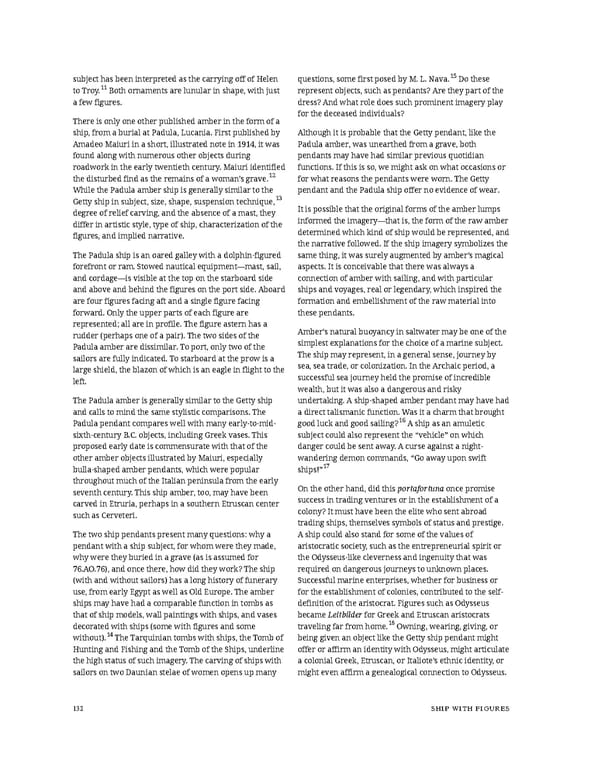subject has been interpreted as the carrying off of Helen questions, some first posed by M. L. Nava.15 Do these to Troy.11 Both ornaments are lunular in shape, with just represent objects, such as pendants? Are they part of the a few figures. dress? And what role does such prominent imagery play for the deceased individuals? There is only one other published amber in the form of a ship, from a burial at Padula, Lucania. First published by Although it is probable that the Getty pendant, like the Amadeo Maiuri in a short, illustrated note in 1914, it was Padula amber, was unearthed from a grave, both found along with numerous other objects during pendants may have had similar previous quotidian roadwork in the early twentieth century. Maiuri identified functions. If this is so, we might ask on what occasions or the disturbed find as the remains of a woman’s grave.12 for what reasons the pendants were worn. The Getty While the Padula amber ship is generally similar to the pendant and the Padula ship offer no evidence of wear. Getty ship in subject, size, shape, suspension technique,13 degree of relief carving, and the absence of a mast, they It is possible that the original forms of the amber lumps differ in artistic style, type of ship, characterization of the informed the imagery—that is, the form of the raw amber figures, and implied narrative. determined which kind of ship would be represented, and the narrative followed. If the ship imagery symbolizes the The Padula ship is an oared galley with a dolphin-figured same thing, it was surely augmented by amber’s magical forefront or ram. Stowed nautical equipment—mast, sail, aspects. It is conceivable that there was always a and cordage—is visible at the top on the starboard side connection of amber with sailing, and with particular and above and behind the figures on the port side. Aboard ships and voyages, real or legendary, which inspired the are four figures facing aft and a single figure facing formation and embellishment of the raw material into forward. Only the upper parts of each figure are these pendants. represented; all are in profile. The figure astern has a rudder (perhaps one of a pair). The two sides of the Amber’s natural buoyancy in saltwater may be one of the Padula amber are dissimilar. To port, only two of the simplest explanations for the choice of a marine subject. sailors are fully indicated. To starboard at the prow is a The ship may represent, in a general sense, journey by large shield, the blazon of which is an eagle in flight to the sea, sea trade, or colonization. In the Archaic period, a left. successful sea journey held the promise of incredible wealth, but it was also a dangerous and risky The Padula amber is generally similar to the Getty ship undertaking. A ship-shaped amber pendant may have had and calls to mind the same stylistic comparisons. The a direct talismanic function. Was it a charm that brought Padula pendant compares well with many early-to-mid- good luck and good sailing?16 A ship as an amuletic sixth-century B.C. objects, including Greek vases. This subject could also represent the “vehicle” on which proposed early date is commensurate with that of the danger could be sent away. A curse against a night- other amber objects illustrated by Maiuri, especially wandering demon commands, “Go away upon swift bulla-shaped amber pendants, which were popular ships!”17 throughout much of the Italian peninsula from the early seventh century. This ship amber, too, may have been On the other hand, did this portafortuna once promise carved in Etruria, perhaps in a southern Etruscan center success in trading ventures or in the establishment of a such as Cerveteri. colony? It must have been the elite who sent abroad trading ships, themselves symbols of status and prestige. The two ship pendants present many questions: why a A ship could also stand for some of the values of pendant with a ship subject, for whom were they made, aristocratic society, such as the entrepreneurial spirit or why were they buried in a grave (as is assumed for the Odysseus-like cleverness and ingenuity that was 76.AO.76), and once there, how did they work? The ship required on dangerous journeys to unknown places. (with and without sailors) has a long history of funerary Successful marine enterprises, whether for business or use, from early Egypt as well as Old Europe. The amber for the establishment of colonies, contributed to the self- ships may have had a comparable function in tombs as definition of the aristocrat. Figures such as Odysseus that of ship models, wall paintings with ships, and vases becameLeitbilderfor Greek and Etruscan aristocrats decorated with ships (some with figures and some traveling far from home.18 Owning, wearing, giving, or without).14 The Tarquinian tombs with ships, the Tomb of being given an object like the Getty ship pendant might Hunting and Fishing and the Tomb of the Ships, underline offer or affirm an identity with Odysseus, might articulate the high status of such imagery. The carving of ships with a colonial Greek, Etruscan, or Italiote’s ethnic identity, or sailors on two Daunian stelae of women opens up many might even affirm a genealogical connection to Odysseus. 132 SHIP WITH FIGURES
 Ancient Carved Ambers in the J. Paul Getty Museum Page 141 Page 143
Ancient Carved Ambers in the J. Paul Getty Museum Page 141 Page 143